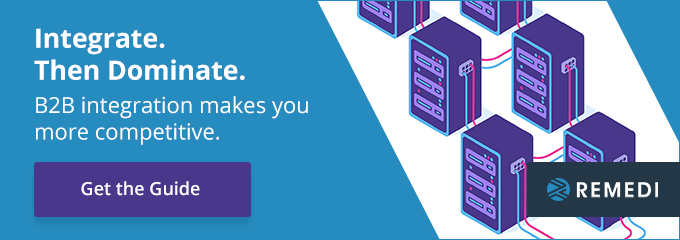
When you think about system integration, we bet that one of the first things that come to mind isn’t how much value you can deliver to your customers. Yet, system integration can deliver enormous value to customers.
Read on to learn about how the six steps of system integration increase productivity, improve workflows, and boost your company’s value to your customers.
What is System Integration?
Remedi defines system integration as “the exchange and integration of electronic organizational transactions, messages, and files through intra-company business processes that connect internal systems and data collection devices.”
Here’s a real-life example of system integration: you want to bring together your order fulfillment system, your CRM, and your chatbot so that information resides in one place instead of in silos across the company. Middleware allows data to flow between systems, and it brings the data into a single location.

How to Integrate Systems
There are six steps to system integration:
- Understanding your requirements
- Determine operational feasibility
- Architecture design
- Systems integration design
- Implementation
- Maintenance
In the first step, you take the time to understand which systems you want to be integrated and what you expect from that integration. In the example we used above, integrating your order fulfillment system, your CRM, and your chatbot would give your customer up-to-date information about where their order is and when they can expect it. Determining operational feasibility means that data integration consulting experts discuss what’s possible and what might not work. The consultant wants to find the best solution for your needs so that you can create value for your customers.
“Architecture design” means that the consultant produces a blueprint of the system integration. This blueprint shows how disparate systems will exchange information with one another. The next step, systems integration design, makes the blueprint a reality, while the fifth step, implementation, involves verification and testing of the design. Maintenance, the final step, ensures that the design works properly and there are no bugs.
Improving your Systems through Integration
Integrating disparate legacy software components and applications can boost your company’s productivity, efficiency and customer satisfaction. It breaks down data silos to encourage information exchange between systems, consolidating and speeding up workflows.
System integration also lets you automate rote tasks, cutting down on manual work and its associated high level of errors. Greater efficiency frees up company personnel so they can focus on higher-level, revenue-generating work. It allows you to respond to situations sooner, make better-informed decisions and optimize your resource allocation.
Integrated systems can result in better customer servicing, too, and will likely lead to more satisfied customers. With information readily available across departments, customer service representatives will be able to fix problems faster and answer questions more accurately, increasing customer satisfaction. With the ability to offer personalized experiences and customized product recommendations, system integration can enhance customer loyalty.
Good integration design and implementation can also extend your system's lifespan. Here’s why: incorporating new functionalities from modern applications allows a system to remain relevant and useful longer. And that saves you money.
Real-World Examples of Integration Improvements
To illustrate the improvements the legacy system integration can bring, here are two real-world examples from companies that engaged Remedi solutions and saw significant improvements -- and solid return on investment.
Regional Power Company
Situation: An energy provider with a diversified portfolio consisting of traditional and renewable power sources wanted to move its onsite IBM Sterling B2B Integrator--a transaction engine--to the cloud.
The company required a fix that would abide by the standards of the North American Energy Standards Board and the Gas Industry Standards Board while allowing it to migrate its electronic data interchange processes to the cloud--without disrupting its customers or trading partners.
Solution: The utility company asked Remedi to conceive, implement and manage a phased migration of its transaction engine and use the Remedi Framework--an IBM-verified partner solution--to increase transparency into transactions and consolidate its workflows.
The first phase of Remedi's work for the client entailed installation, testing, business process development and message portal configuration. The second phase involved migrating trading partner configurations to the cloud, then testing and managing the migration.
Impact on Business: Remedi Framework's pre-built workflows enabled the team to put the new software platform in place and migrate partner configurations to the cloud in a quarter of the time the power company had anticipated before engaging Remedi.
Logistics and Transportation Company
Situation: In its early days, a family-owned transport business used Cleo Harmony, a file integration solution, and Cleo Clarify, a business integration middleware, for data movement and data transformation, respectively. As the business grew, however, these solutions became less stable and more error-prone, making clear that the company had outgrown them.
Solution: The business decided to switch to Cleo Integration Cloud, a well-known, reliable, cloud-based integration platform. The company engaged Remedi for integration consulting, to help lead the migration effort and execute the planned growth strategy.
Impact on Business: Remedi implemented the migration--without disruption to operations or trading partners. The problems that plagued the company prior to the move--missing load tenders, for example--became a thing of the past and now no longer slow business or frustrate trading partners. The solution has given the logistics firm the means to grow its revenue.
What About Integrating Legacy Systems?
You might be reading this and thinking, “This is all well and good, but my company uses legacy systems. How I can integrate them?”
Legacy systems contain vital information that some companies use on a daily basis. Unfortunately, a rip-and-replace is an expensive proposition, especially when the system works without serious problems. Data integration consulting experts can work with you to find a solution that integrates your legacy system for greater visibility and enables you to deliver value to your customers.
How Systems Integration Benefits Your Business
Systems integration has some key benefits for your bottom line, including cost savings, higher revenue, better customer retention and improved competitive advantage. Here are some examples from the business world that illustrate the power of integration in achieving each of these outcomes:
Cost Savings: Global fast-food restaurant McDonald's put into place a comprehensive enterprise resource planning system across its entire franchise network. Doing so centralized inventory management, and financial and supply-chain operations, the company cut down on its procurement spend and food waste and improved its supply-chain logistics.
Increased Revenue: Well-known customer relationship management platform Salesforce integrated with marketing automation firm Pardot to create a seamless customer engagement experience. The integration allowed companies to use client data from Salesforce to power targeted marketing efforts with Pardot. The result? Higher conversion rates and greater revenue.
Improved Customer Retention: One of the ways that e-commerce giant Amazon has achieved its high rates of customer retention is through the integration of customer support systems with data analytics. The company uses real-time information collected from customer interactions to constantly improve services, proactively address system issues and better anticipate customer needs and wants.
Competitive Advantage: Electric vehicle firm Tesla used Internet of Things in conjunction with data analytics integration to revamp the auto sector. By integrating data analytics and sensors into its cars, Tesla is able to gather performance and usage information that lets it perform remote diagnostics, proactively fix issues before they become problems and regularly update software. All of this combines to give Tesla a competitive edge in vehicle performance.
By bringing all of your information into one place, you create a better experience for your customers. Again, we’ll go back to the example we previously cited with order fulfillment, CRM, and chatbot integration; the chatbot provides a self-service option, saving your customer valuable time. In addition, the information is accurate and up-to-date, so the customer isn’t left wondering where his order is.
Moreover, you improve your own workflows – your employees don’t waste time hunting for information because it’s all in one place. You can be more efficient and productive.



